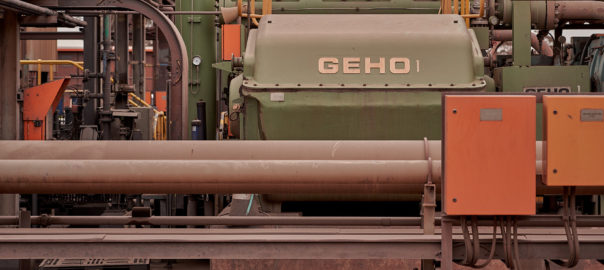Weir Minerals’ GEHO® positive displacement pumps are helping SIMEC Mining keep up its production goals at the Whyalla steelworks in South Australia.
SIMEC produces iron ore concentrate for the steelworks from a 10 Mt/y iron ore mine in the Middleback Ranges of South Australia, with the GEHO pump’s responsible for transporting the slurry 67 km from the plant to Whyalla, where it is then dewatered and converted to pellets for the steelmaking process. SIMEC has two GEHO PD pumps on site, which, through high pressure pumping, ensure the material stays suspended in the pipeline throughout the journey.
“The GEHO pumps transport the slurry about 250 cubic metres an hour, 300 tonnes an hour into town,” Chris Stanton, Senior Process Engineer, SIMEC Mining, said. “They run every day, all day and are very powerful pumps. They have defined maintenance intervals that allow us to run each pump for the nominal amount of time without any risk of breakdown.”
As the pumps are critical for both the plant and steelworks, it’s crucial they are well maintained to continue to perform year after year. This is made possible through the close partnership between Weir Minerals and SIMEC Mining, according to Weir.
Anthony Sheely, Concentrator Operations Coordinator, SIMEC Mining, said: “If the GEHO pumps didn’t operate properly then the pipeline would be at risk, and that would be a major issue as the pipeline is the lifeblood for both our operation and the entire township of Whyalla.”
Pumping long distance is a critical requirement at many mines around the world, but often comes with challenges and key design considerations that operators must be mindful of.
Peter Thissen, Global Product Manager for GEHO pumps at Weir Minerals, said: “The biggest challenge of long-distance pumping is generating slurry with a suitable particle size distribution for the application. Operators must concentrate the particle size distribution to make it a pumpable slurry whilst trying to minimise the amount of water used in the process.”
He added: “We deal predominantly with high solids concentrations, which is becoming more important in both a water constrained and environmentally sensitive industry. Our depth of experience and knowledge together with the delivery of innovative designs has provided effective solutions to meet our customers’ needs around the world.”
Designing a pipeline like the one for Whyalla is a complex balancing act between the rate of flow, the concentration of slurry and the size of particles, according to Weir. For solids in slurry to remain in suspension, they need to be moved by the liquid at a minimum velocity.
Another challenge operators are faced with is the pipeline route. This must be the most economic means of transportation and suitable for the flow behaviour of the material.
Thissen says: “It’s much easier to build a pipeline on flat land as it stays horizontal and the operational condition for the materials is constant, as long as we can keep the particles in suspension. However, if we have to cross rivers, mountains or valleys then the pipeline will be built on an angle and great consideration must be given to the design of the pipeline, transport velocities and starting and stopping the pipeline.”
Weir Minerals’ GEHO crankshaft driven pumps are among the world’s most advanced positive displacement pumps, according to Weir. They are designed to transport slurry over long distances, reaching up to 550 km and more than 2,000 m uphill.
Thissen says: “Our GEHO pumps are designed to handle high-density slurry with solids up to 85%. With extremely high availability, low energy consumption and operating costs they ensure uninterrupted, trouble-free operation.”
The diaphragm in the pump separates the abrasive slurry from the operating components, with the exception of the valves, protecting them from wear and ultimately prolonging the life of the pump, according to Weir.
“What this means for the operator is significant savings for wear parts, resulting in a very economic and extremely reliable product for pipeline transportation,” Weir said. “If maintained properly the GEHO pumps continue to run year after year, 24 hours a day; with references of GEHO pumps in operation for 30+ years.”
Thissen concluded: “As long as the make-up of the slurry doesn’t change and pumping conditions remain the same, our GEHO pumps will continue to operate indefinitely. Combined with long maintenance intervals and highly dedicated service engineers, they keep processing plants operating at peak performance while delivering a low total cost of ownership.”







